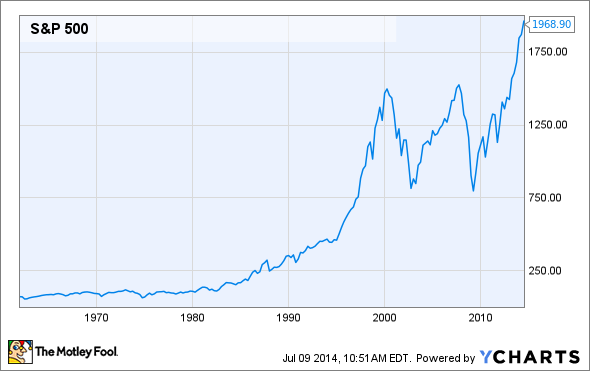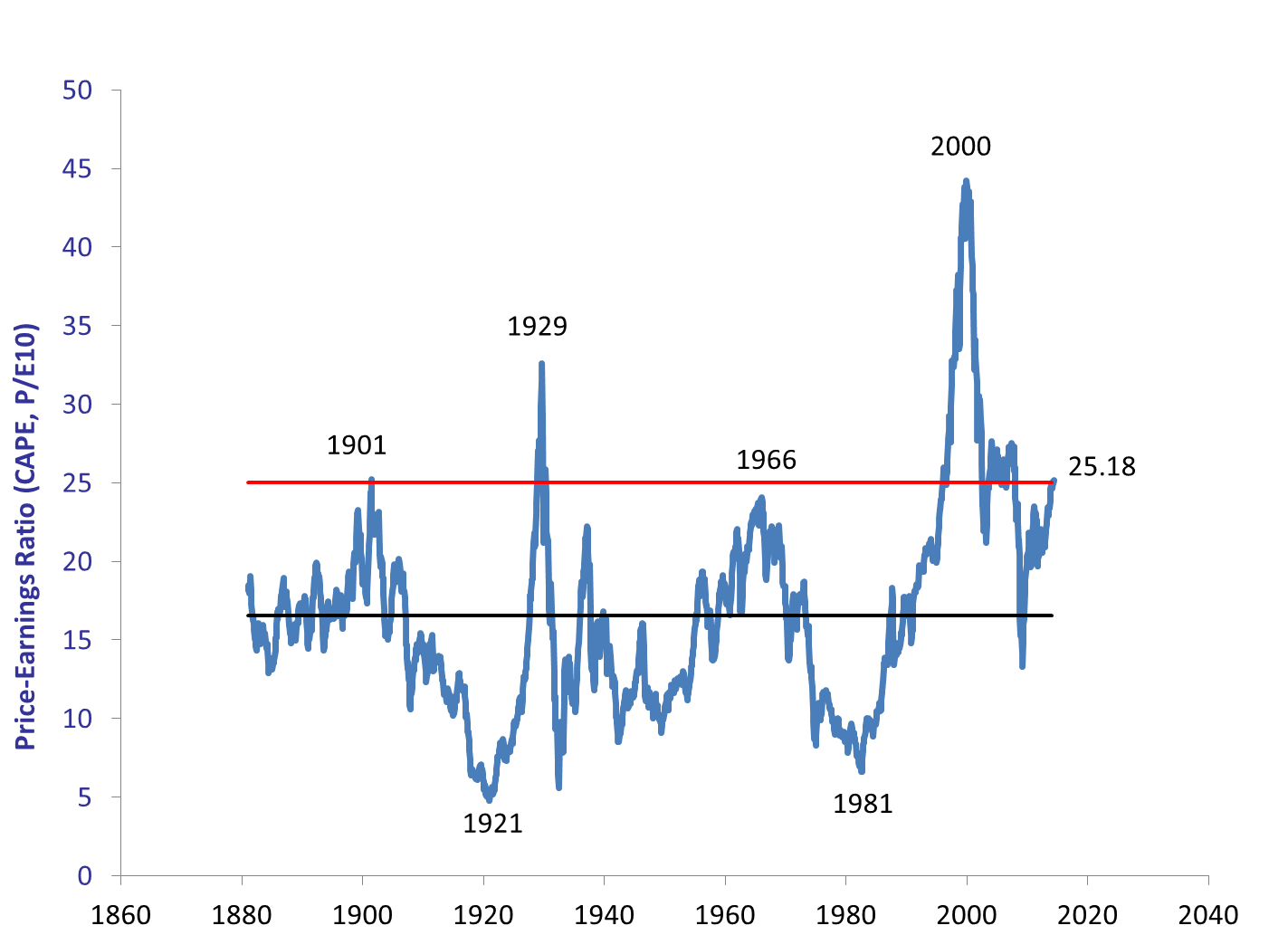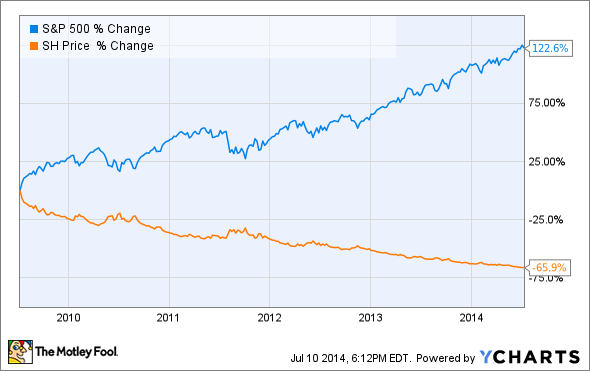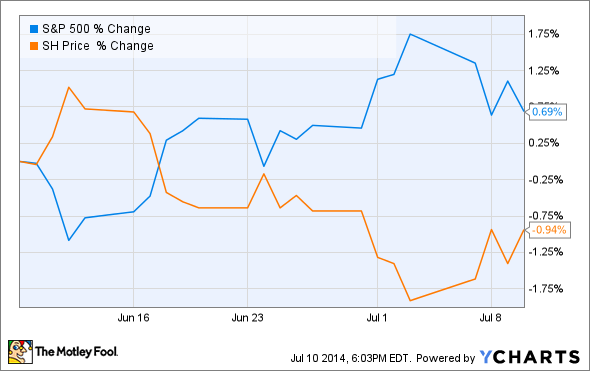I’m typically an optimist, especially when it comes to the United States economy. But if there is one lesson that history has taught investors, it’s that the market moves in cycles. The market has been hitting a lot of new all-time highs recently, and it has made me start to think about how to best position my money for the inevitable cyclical downturn that is coming at some point. Today I’m going to take a look at three ways to bet on a market decline: short selling or buying put options in individual stocks, such as Charles Schwab Corporation (NYSE: SCHW), investing in precious metals, such as SPDR Gold Trust ETF (NYSEMKT: GLD), and buying inverse ETFs, such as Short S&P 500 ProShares (NYSEMKT: SH).
Is the market really overpriced?
Just because the market has risen so much doesn’t necessarily mean that the rise isn’t justified by the underlying economic growth. One of the big problems I see with traders is their inability to look at the market with the proper perspective .
The S&P is up 188% since its low of 683 back in 2009. During that five-year stretch, the S&P has only seen one 20% pullback, a drop of only 21% in 2011. If you have any sense of objectivity about the market, that chart should really get your attention. It’s one thing to hear on the news that the market is making new all-time highs, but a chart like that really hammers home just how historically high the S&P 500 is at this time. But a high price doesn’t necessarily mean that the market is overpriced. What really matters is the price of the market relative to the performance of the companies, and my preferred way to take a look at how expensive the market is is Robert Shiller’s CAPE, a 10-year inflation-adjusted price/earnings ratio:
The S&P 500 CAPE has been above 25 (the red line on the chart) less than 9% of the time since 1881.
Yes, this market is expensive. So what are we supposed to do about it other than sell our stocks and cower under a pile of cash until we feel safer?
Short sell individual stocks
Short selling individual stocks is one way to profit off of a declining stock market, but there are risks involved. There are two inherent benefits to owning shares of stock. One benefit is that the market, volatile as it may be, has a general upward trend over time because of the economic growth of the United States economy. The other advantage to owning shares of stock is that your maximum risk is a 100% loss, while your maximum reward is potentially limitless.
When you short sell a stock, these two advantages are flipped to disadvantages. The best you are going to do is a 100% gain, and, let’s face it, the odds of picking a stock that will go to zero are very slim. So realistically, during a 30% drop in the market, you can hope for a 50-60% gain if you’re talented at picking the right stocks to short.
When choosing which stocks to short, I look for overvalued, cyclical stocks such as Charles Schwab. As fellow fool Kingkarn Amjaroen recently pointed out, Schwab’s business is based on traders’ willingness to invest in and trade stocks. Not surprisingly, Schwab’s bottom line tends to grow and shrink right along with the market, so the stock is a good short-selling candidate for someone who believes that the overall market will be taking a downturn. In addition, at over 3.7 times book value, Schwab stock is looking pretty expensive lately.
Buy put options
If the idea of capping your gains at 100% with unlimited losses doesn’t appeal to you, one way to bet on a market downturn and keep the risk/reward maximums in your favor is to buy put options. Put options limit your losses to 100% while allowing gains of much greater than 100%.
One disadvantage of buying put options is that timing is critical. Yeah, the market is expensive. But the CAPE was at 25 back in 2003, and the subsequent market correction didn’t occur until more than four years later. By the time the market finally crashed, any put options purchased in 2003 were likely long-expired.
And the farther into the future your option expiration date is, the more expensive the time-related premium will be on the option. In other words, the farther into the future your expiration date, the more you will need the market to drop to make any profit. For example, January 2016 Charles Schwab puts with a strike price of $27 currently cost $4.10, meaning that buyers of these at-the-money puts would need nearly a 15% drop in share price by expiration just to break even.
Buy precious metals
One indirect way to bet against the market is to bet on something that investors tend to flock to when they are scared: gold. Any time there is economic uncertainty, the prices of gold and other commodities tend to spike because investors view gold as something that holds intrinsic value that other investments do not. The idea of gold’s “intrinsic value” has always struck me as strange because if I were stranded on a deserted island, a gold nugget and a chunk of limestone would hold pretty much the same value to me.
Nevertheless, when investors get scared, they buy gold. But the major problem with gold is that it doesn’t directly trade inversely to the market. In fact sometimes it even demonstrates a positive correlation. One of the easiest ways to invest in gold without needing a treasure chest buried in your backyard is to buy shares of the SPDR Gold Trust Exchange Traded Fund (ETF). 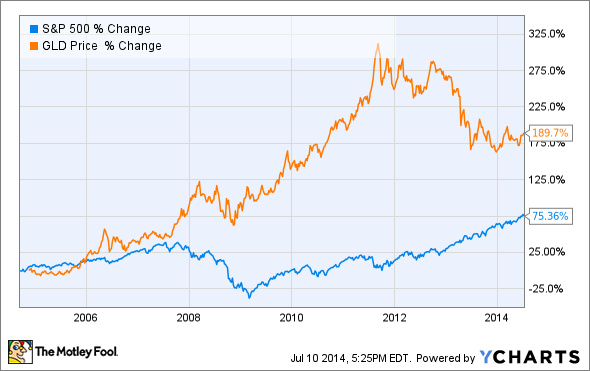
The price of gold typically rises in times of fear, which is usually the same time the market is falling. But because there is no direct inverse correlation between gold and the market, the magnitude of the rise in gold prices during a market downturn can be unpredictable or completely nonexistent.
Buy an inverse ETF
Inverse ETFs are funds comprised of stocks and derivatives that are intended to trade inversely to a particular target. Many inverse ETFs are meant to trade inversely to the broad market, by mirroring the S&P 500, Nasdaq 100, or Dow Jones Industrial Average. Others are intended to trade inversely to a specific sector of the market.
The advantages to owning an inverse ETF include diversification, no margin requirement, no time constraints or time premiums, and a correlation to the overall market that is at least close to a perfect inverse. Take a look at this 5-year chart of the S&P 500 compared to one of its inverse ETFs, Short S&P 500 ProShares.
The only major drawback of inverse ETFs is that the correlation with the underlying asset (in this case, the S&P 500) is not perfect, and that imperfection can get compounded over time. For example, if we look at a one-month chart of the S&P 500 versus this inverse ETF, we get nearly perfect inverse correlation.
The difference between the performance of the inverse ETF and the expected performance over one month was only 0.25%. However, over the ten year period shown in the first graph, the difference between the gain in the S&P 500 and the loss in its inverse ETF is more than 56%. In this case, the disconnect between the return of the inverse ETF and the return of the underlying market happens to be a good thing for ETF holders, and the fact that the ETF price can’t fall more than 100% worked to shareholders’ advantage. But this disconnect may not always be a good thing for shareholders.
What’s the verdict?
Unfortunately, there’s no perfect way to bet on a falling stock market. However, with no margin requirement, limited risk, and decent correlation to the underlying market, my method of choice would be to buy an inverse ETF.
I want to take a minute to thank all the people that bought my book this past weekend while it was on sale. I hope you enjoy reading.
Does the market seem completely random to you sometimes? Trust me: it’s not. Or maybe you just want to be able to look sophisticated in front of your coworkers when they ask you what you are reading on your Kindle, and you’d prefer to tell them “Oh, I’m just reading a book about stock market analysis,” rather than the usual “Oh, I’m just looking at pics of my ex-girlfriend on Facebook.” For these reasons and more, check out my book, Beating Wall Street with Common Sense. I don’t have a degree in finance; I have a degree in neuroscience. You don’t have to predict what stocks will do if you can predict what traders will do and be one step ahead of them. I made a 400% return in the stock market over five years using only basic principles of psychology and common sense. Beating Wall Street with Common Sense is now available on Amazon, and tradingcommonsense.com is always available on your local internet!
